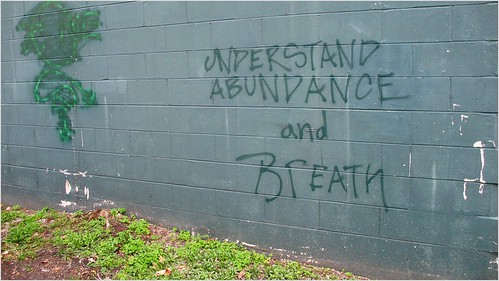
Is that a Zen graffiti artist? Did he run out of paint before spraying the letter “e”? Who knows, but if nonprofits embrace abundance, wouldn’t it give them more time to breathe? Trying to do everything, a scarcity model, is such an exhausting way to work.
Marnie Webb has been thinking about how the nonprofit sector might be different if organizations believed in abundance and re-thought their organizational structures and how they delivered programs as a result. Marnie points out that working in a networked way and using social media can help actualize that belief in abundance. She says, ” Social media, and the robust search and listening tools available to us today, can help us find the people who are talking about, the people who are supporting our causes. Networks can help us build the capacity to take advantage of different institutional skills. ” Marnie talks about the importance of data aggregation and synthesis skills as a new competency for nonprofits.
Marnie asks a great question about the organizational structures needed to actualize abundance:
So, if we are building organizations on the abundance of goodwill, energy and eager hands — and if we are thinking of ourselves, organizationally, as platforms for change rather than agents for change. If we thinking that way, what are the organizational structures that we have to build?
In a follow up post, Marnie answers her own question or rather begins to noodle on it. She says that organizations should support the good work that is happening elsewhere. She uses the word “curate” which makes me imagine nonprofits as museum curators. Museum curators have expertise in a particular area of art, they know the ecosystem around the art – the artists, the patrons, other collectors, and other museum curators interested in that art form. When they create an exhibit, they pick the best examples and put them together in a new and exciting way — the institution lends it support to give the works visibility. The museum itself does not create the art, but puts into a context and connects with a broader number of people.
Marnie suggests that nonprofits need to bring curator skills to their program work:
This means you have to be able to find projects, you have to be organizationally egoless in finding out what you can do to help these projects, you have to be as non-disrutptive to the actual work as possible.
She also admits that shift from artist to curator is not an easy one for many nonprofits because of the way they are structured.
Nonprofits are built to take ownership of the tasks that lead to the change we are trying to bring about — the tasks of feeding people or providing job training …. And, sure, those tasks need to get done. But maybe we should start taking ownership of the impact and the change — describing it, pointing out the gaps, getting more resources to fill holes, and we should ask for more help on the tasks. We should find other people who are doing those tasks and build on it.
Marnie points out how nonprofits need to build out new structures so they work effectively with “free agents” or as she puts it “enabling the energy around them.” She describes this as part of the “gig economy” and gives us description of how these new nonprofit entities might work. Sounds more like a network than an organization?
Nonprofits-as-venues needs to be about project curation but also about providing the support and structure that may be harder for free agents, individually or together, to do. This may be things like seeking and managing funding, writing checks to necessary contractors or suppliers. But it might also be about long-term evaluations. It might be about stitching together the lessons and impacts of various projects to talk about a whole issue or present a picture of an entire community. Nonprofits can build a platform of community impact data and feed that back to the world at large — informing funding trends, municipal government decisions, and the next set of projects taken on by these collections of free agents.
Marnie has shared a lot here and it raises lots more questions than answers …
- Is there a hybrid version where nonprofits do a combination of curating and doing? Or are we talking about all curation?
- What needs to change in the way that nonprofits are structured and their culture to make this happen?
- Are there good examples of organizations working in this new way that can inspire us?
